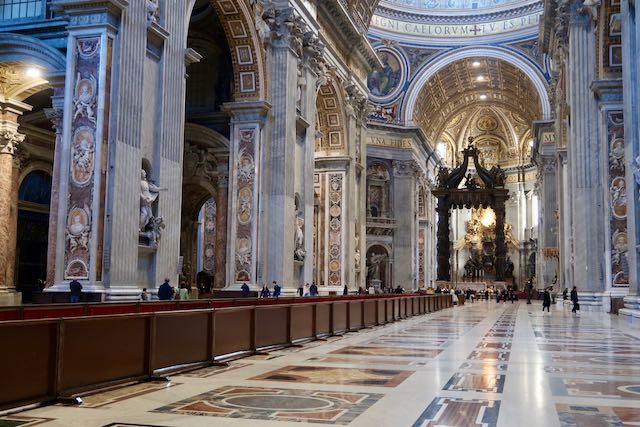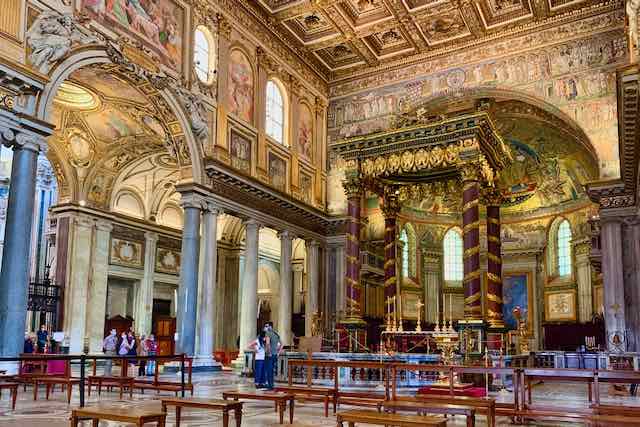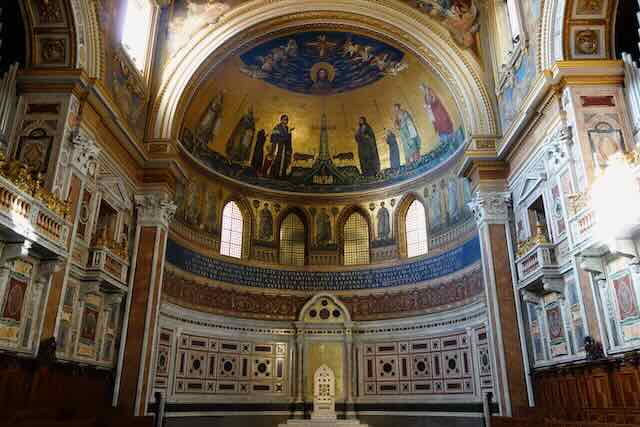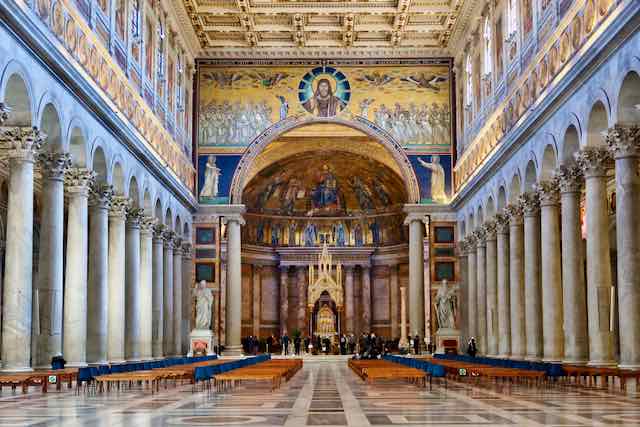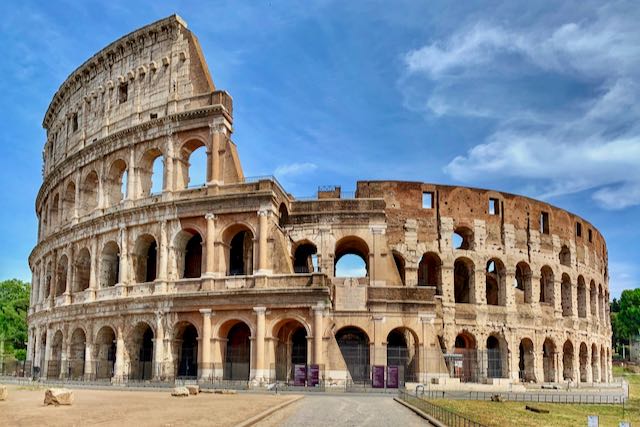- Sign up & get a FREE ebook Subscribe NOW!
- Romewise Home Page
- What to Do in Rome
- Romantic Things to Do in Rome
- Special Churches in Rome
10 Special Churches in Rome That Will Amaze You!
Do you want to see some special churches in Rome, often hiding in plain sight?
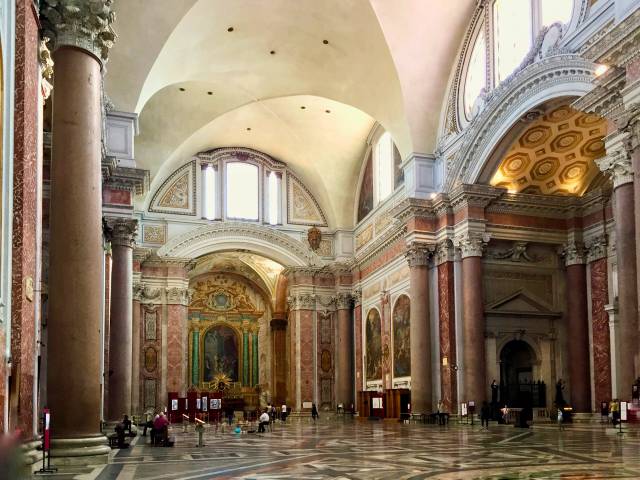 This stunning basilica was built into the Ancient Roman baths of Diocelitian. Michelangelo designed the vaulted ceiling. It was the last architectural work he did before he died.
This stunning basilica was built into the Ancient Roman baths of Diocelitian. Michelangelo designed the vaulted ceiling. It was the last architectural work he did before he died.From the Byzantine to the Baroque, these are some of my favorite churches in Rome.
I love their centuries of layered history, shimmering mosaics, stunning architecture, and hidden secrets that you have to know about in order to find them.
This is what I want to share with you.
Special Churches in Rome - My top 10
No time to read the whole page?
This is a long page - I put a lot of heart and soul into it because I wanted to share some of the most interesting details about some of my favorite churches in Rome.
But if you don't have time to read the whole thing, and/or you don't have time to visit all these churches, here are my top 3 from this page:
- Santa Maria degli Angeli e dei Martiri (photo at the top of this page) - this basilica was built into the ruins of the Baths of Diocletian. It was Michelangelo's last architectural works before he died. This church has Ancient Rome, my favorite artist of all time, and a fascinating trick on the floor I just love.
- Santi Quattro Coronati - this basilica is part of a large monastery complex. I love walking through the various doors to get to the church which in the end, turns out to be kind of small due to the fact that it was rebuilt after being sacked. Despite its size, the church wows me every time. There is something about the light coming in, the frescoed vault, and that Cosmatesque floor I love so much. My favorite things in this church are its hidden secrets - the Oratory of San Sylvester, the contemplative cloister, and the astounding Gothic Hall.
- Sant'Andrea al Quirinale - This was Bernini's favorite of his architectural achievements. If it works for him, it works for me. I always feel like I've stepped into a giant Fabergé egg. I love the swooshy designs of the façade and of the ceiling, and I love the shape of the interior. I also love that almost nobody notices it as they walk past one of the most stunning baroque masterpieces we have in Rome.
Tour rating:
(4.3/5 stars)
Rome has nearly a thousand churches.
Most of them, even the small hidden ones, are worth a visit.
I could easily make a page about my top 100 churches in Rome, but let's stick to 10 so it's manageable.
I'm leaving out the big papal basilicas of St Peter's, Saint Mary Major, Saint Paul Outside the Walls, and San Giovanni in Laterano.
This list of my top 10 favorite special churches in Rome is mostly about churches that are under-visited, little-known, and typically an oasis of quiet and calm.
They also tend to have something unique to see that I think is worth seeking out.
The churches are in more or less geographical order, so you can visit them one after the other if you like.
You could also split them up by neighborhood:
- Sant'Andrea al Quirinale - Bernini's favourite work of his own
- Santa Maria degli Angeli e dei Martiri - Michelangelo's last work before he died
- Santa Prassede - the most beautiful Byzantine mosaics in Rome
- Santi Quattro Coronati - a stunning ancient monastery with one of Rome's most important medieval chapels
- Santo Stefano Rotondo - a spectacular round church with gruesome artwork
- Santa Maria in Domnica - more Byzantine mosaics
- Santi Giovanni e Paolo - an ancient church with Roman ruins underneath
- Santi Cosma e Damiano - built on top of an ancient Roman temple
- Sant'Ignazio - the best optical illusions in Rome
- Sant'Agostino - a stunning Caravaggio masterpiece, and more
I've mapped out a walking route of all these churches so you can see them all in one morning or afternoon.
Sant'Andrea al Quirinale
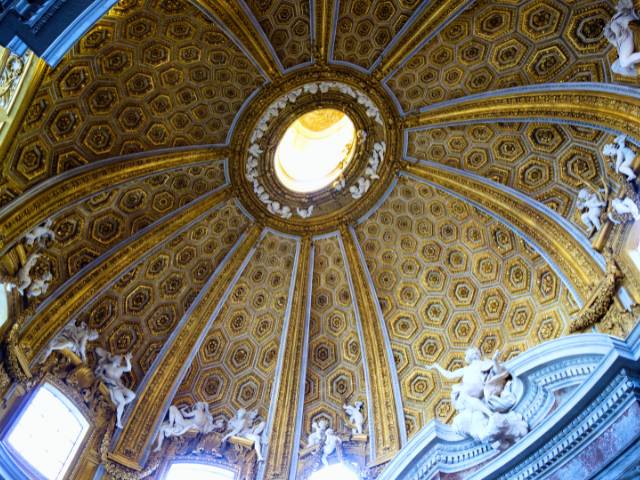
Imagine you are the artistic genius Gian Lorenzo Bernini, and towards the end of your amazing life and very rich career as a sculptor, architect, painter and more, your favourite piece of work, the one you think was your most perfect, is this church.
And you still have time in your twilight years to sit inside it, contemplating what you did.
Isn't that a lovely thought?
It's something I think of every time I go inside.
I love to think that Bernini sat inside his masterpiece, looking around him at the wonder he created, and loving it as much as I do.
Sant'Andrea al Quirinale has to be one of the most easily over-looked, special churches in Rome, even though it's in plain site.
It's just across from the Quirinale palace on a busy street, XX Settembre.
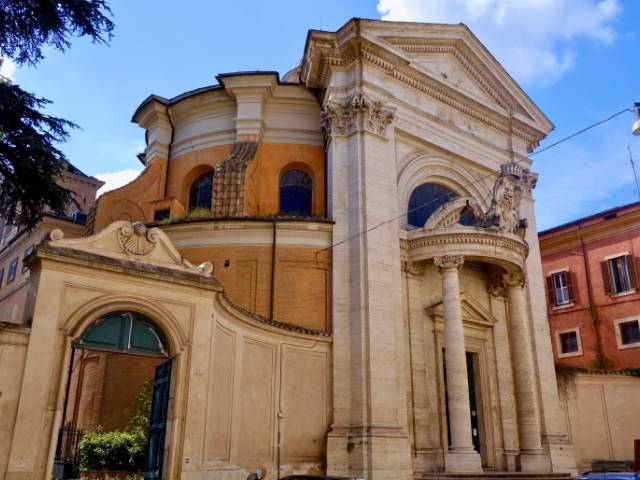
But I often see people walking right by it without realising the magnificent work of art that it is.
If you look at the façade, you will already see why it's special, even from the outside.
Its rounded front, and curved steps combine to make a unified movement that pleases the eye.
Once inside, the elliptical dome, soaring columns, and symmetrical chapels and nooks all envelop you to make you feel like you are inside a hand-cut Fabergé egg.
Sant'Andrea al Quirinale - a short history
Sant'Andrea was the third Jesuit church built in Rome (after the Gesù and Saint Ignatius).
Initially the architect Francesco Borromini (Bernini's rival) was to design this church, but by the time there was funding, the pope at the time, Innocent X, said no to the project.
He didn't want any large buildings next to the papal palace (the Quirinale.)
After Innocent X died, the next pope, Alexander VII, who was a big fan of Bernini and who did not like Borromini, put Bernini back on the project.
But Alexander VII stipulated that the church must be built back from the street, and that a wall must hide it from street view.
Bernini focused on building the interior and left the façade to last.
Eventually Pope Alexander VII died, and by then, his decree was forgotten.
The façade that you see today went up with the Pamphilj's coat of arms at the top (Pope Innocent X was a Pamphilj).
It was his nephew Cardinale Camillo Pamphilj who eventually financed the church.
The church of Sant'Andrea is one of the best examples of Baroque architecture in Rome today.
Sant'Andrea al Quirinale - Special Things to Note
Bernini did not want to be paid
Bernini did not accept payment for designing this church.
He was a devout man, and asked only that he be given bread baked by the novitiates during its building.
⭐️ Marvel at Rome's Stunning Architecture ⭐️
Dive into Rome's majestic basilicas and architectural marvels. Visit San Giovanni, Santa Maria Maggiore, and the Pantheon to uncover the rich history and beauty of these iconic sites.
Colorful Columns
Note the red and white marble columns.
For centuries, it was common to loot ancient Roman ruins to get marble to build other things (such as Saint Peters Basilica, to name one), but Bernini wanted his columns to be uniform and he knew how he wanted them to look.
So he got the marble from a quarry in nearby Rieti.
The Elliptical Dome
Look at how the dome is elliptical not only in height but in width as well.
Normally, you'd expect for a church to open up from its entrance towards the back.
Instead, this church opens up wide above you but also to the left and right.
If you lose yourself in the swerving curves of the marble, light and pillars all around you, you can almost feel as if you have stepped through the looking glass.
San Carlo Alle Quattro Fontane - another Baroque treasure
I shouldn't lump this into a section about Bernini's masterpiece, as I doubt Francesco Borromini would be happy about it, but you should absolutely also visit Borromini's church, San Carlo just down the street.
First of all, the two were rivals, so that already makes it interesting to compare the two buildings.
Second of all, Borromini made his church elliptical as well, but in the way you'd expect, with the length of the church starting in front and moving long-wise towards the back.
This is opposed to Bernini's church, whose oval shape is left-right.
There is more to compare, but I would urge you to see them both.
Sant'Andrea al Quirinale - Address and Hours
Via del Quirinale, 29
Tuesday - Sunday 8:30am - 12 pm, 2:30 pm - 6 pm.
Closed Mondays
Santa Maria degli Angeli e dei Martiri
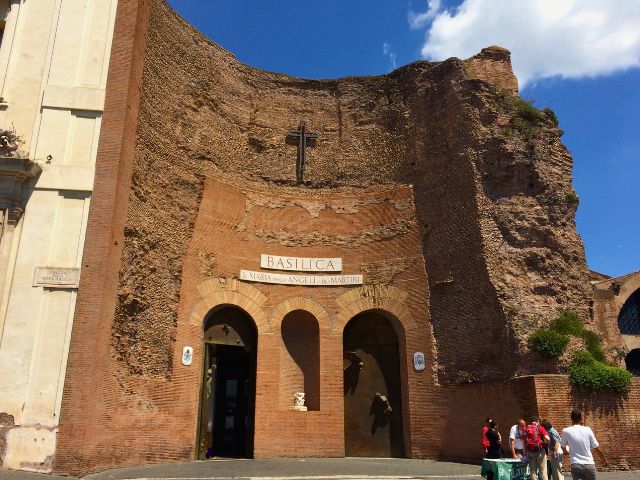
When I was first coming to Rome a lot to visit Alessandro, I stayed near Termini station.
And, on my walks towards the center, I'd pass Piazza della Repubblica.
It did not take long for me to decide to pop into this church.
Since that moment when it completely wowed me, it has remained one of my all-time favourite churches in Rome.
Like so many churches in Rome, it was built onto something else - in this case, the ruins of the ancient Diocletian baths.
Over the centuries, the entrance to the basilica was moved to what was one side, so now, when you enter it from Piazza della Repubblica, you don't get the full effect of the church until you are all the way in.
And since basilicas are long, when you get fully in, the church stretches out to the left and right of you.
It has incredibly high ceilings that let in so much light.
For me, this church always has a serene, almost heavenly glow about it.
The church is called Santa Maria degli Angeli e dei Martiri, which means Saint Mary of the Angels and the Martyrs.
And the artwork reflects this (although it is not nearly as gruesome as the artwork in Santo Stefano Rotondo).
Santa Maria degli Angeli e dei Martiri - A Short History
The Diocletian baths were built between 298 and 306 CE, and were much larger than the Caracalla baths.
While you can still see relatively intact ruins of the Caracalla baths, the Diocletian baths have all but disappeared.
Over the centuries, the baths fell into decay and became over-run with vegetation and animals.
In 1541, a young Sicilian priest named Fra Antonio Lo Duca, who was dedicated to the 7 archangels, had a vision of 7 slaves who had died building the church.
He finally convinced Pope Pius IV to have a church be built on the ruins of these baths in 1561.
The church would be dedicated to angels and martyrs.
Michelangelo was assigned the task of turning the ruins into a church, and it was the last thing he did before he died at the age of 88, in 1564.
Santa Maria degli Angeli e dei Martiri - Special Things to See
The architectural design by michelangelo
For me, the most impressive thing about this basilica is the enormously high vaulted ceiling designed by Michelangelo Buonarroti.
It's especially breathtaking because you don't see it immediately, but rather after you have entered the church and gone through the first domed room.
Then the whole church opens up wide and high before you.
It literally takes my breath away every time, and I bet it will have the same effect on you.
The museum in the sacristy
The sacristy in the back has a little photographic museum showing the development of the church over the centuries.
And just beyond the sacristy, you will find yourself in a small section of the ancient ruins of the Diocletian baths.
The Meridian Line
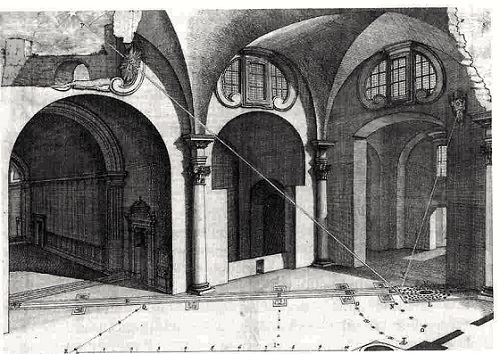
Don't miss the meridian line, which shows the moment of the year via a sunbeam along the floor.
If you look high up in the ceiling corner, you will see the papal coat of arms with a tiny oculus (hole).
The sun shines through this hole and should land on the meridian line when it is noon.
However, it was designed when there was an old time system used in Italy (the Italian hour), and since this time-telling method is no longer used, the meridian line does not actually work quite right.
But it's beautiful to see, as are the zodiac signs on the floor all along the line.
Santa Maria degli Angeli e dei Martiri - Address and Hours
Piazza della Repubblica
Open daily from 7 am - 6:30 pm; Sundays and holidays until 7:30 pm
Basilica of Santa Prassede
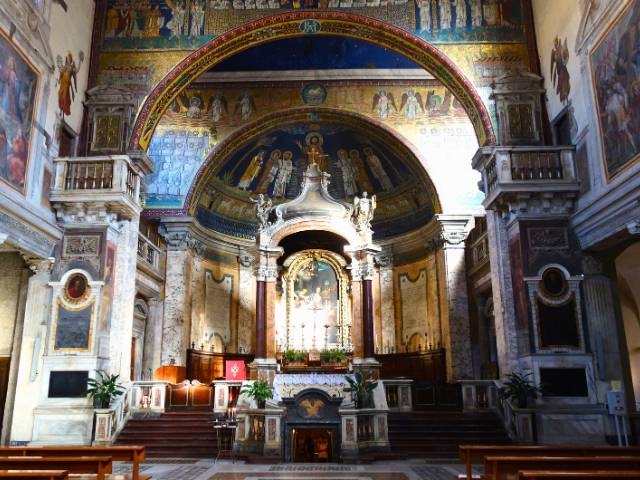 The basilica of Santa Prassede is home to some of Rome's most beautiful Byzantine mosaics.
The basilica of Santa Prassede is home to some of Rome's most beautiful Byzantine mosaics.Unless you look for it, the basilica of Santa Prassede is easy to overlook.
One reason to visit this basilica is if you want to escape the crowds at the basilica of Santa Maria Maggiore just around the corner.
But the main reason is to see the finest example of Byzantine mosaics we have in Rome.
As with so many churches in Rome, it doesn't look like much from the outside.
When you enter this church, you will be coming into it from an entrance that was added long after it was originally built, and it's on the side.
So you can't get the full effect of its beauty until you go in a few paces.
The apse is made entirely of tiny glass mosaics, Byzantine style.
The floor has a cosmatesque design, making it look like a rich tapestry.
(This floor has been heavily restored but you can see some of the original Cosmatesque floors if you go up the steps to the altar or if you enter the San Zeno chapel.)
There is also a special treat: the San Zeno Chapel, made entirely of Byzantine mosaics.
It's worth going into this church just to go into this chapel (and pay the 1€ to light it up.)
Santa Prassede - A Short History
San Prassede is named for Saint Praxedes, who, along with her sister, Pudentia, were daughters of Saint Pudens, supposedly Saint Peter's first Christian convert in Rome.
The story goes that the two sisters helped bury early Christian martyrs, which was against Roman law at the time.
They also were reported to have sponged up the blood of hundreds of martyrs.
This sponge, along with the relics of the two sisters, is in the church's crypt.
You can visit the crypt by walking down a few steps underneath the altar.
The basilica of Santa Prassede was originally built in the 5th century.
Later, in the 9th century, Pope Paschal I had it rebuilt to what is more or less its current form today.
Santa Prassede - Special Things
San Zeno Chapel
Probably the biggest claim to fame of this church is the San Zeno Chapel, a stunning room of literally wall-to-wall Byzantine mosaics.
Take note of the mosaics on the outside of the chapel's entrance, and check out the original floor as well.
Flagellation Column
Inside the San Zeno chapel, you can see the pillar that supposedly Jesus was tied to and flogged before he was crucified.
Early Bernini work
There is a funerary monument of Bishop Giovanni Battista Santoni that was sculpted by a teenaged Gian Lorenzo Bernini, who lived nearby at the time.
There are disputes about when it was exactly built, but it is certainly one of Bernini's earliest works.
Original Entrance
If you walk around the corner to Via di San Martino ai Monti, you can see the original doorway with it's spolia columns.
Santa Prassede - a Curiosity
If you look closely at the mosaic at the top of the apse, you will see that one figure has a square halo (nimbus.)
This figure is Pope Paschal I himself, who commissioned the mosaic.
He was alive at the time, and living holy figures are depicted with square haloes.
Also, when you go inside the San Zeno chapel, look above the doorway on the left-hand side.
You'll see the mother of Pope Paschal, Teodora, to whom the chapel of San Zeno was dedicated, who was alive when the chapel was dedicated.
She also has a square nimbus.
Santa Prassede - Address and Hours
Via di Santa Prassede, 9
Open daily 10 am – 12 pm, 4 pm – 6 pm
The four major (papal) basilicas
Santi Quattro Coronati
Santi Quattro Coronati is a very under-visited monastery, which is sad for anyone who misses it.
It's got a beautiful cosmatesque floor and a stunningly-frescoed, over-sized apse.
But what makes it really special is the oratory of San Silvestro (Saint Sylvester) that contains almost intact frescoes from the 1200s.
One fresco in particular is extremely important because it depicts the Donation of Constantine.
To find out why this is important and to see more of the chapel and how to visit it, watch my YouTube video about it here.
You have to know where to go, and then ask the nuns to open it for you.
They'll ask for a small donation and let you in.
Santi Quattro Coronati - A Short History
The original church was built in the 4th or 5th century, and is dedicated to four martyrs who were put to death by the emperor Domitian (there are various stories about these martyrs and who they were and why they became martyrs.)
They became saints, hence the name of the church, Santi Quattro (4 saints).
The last word in the church's name, Coronati, refers to the coronas, or laurel wreaths, the saints wore.
The church's medieval bell tower (from sometime between 900-1200), was probably the first bell tower in Rome.
The church was used for some time as a defensive structure.
You can still see this today from its thick, fortified, tall walls.
It was burnt during the Sack of Rome in 1084, then rebuilt but much smaller.
This is why the apse seems disproportionately large compared to the naves.
In the 1500's, the basilica was given over to the Augustinian nuns, who still run it today.
Santi Quattro Coronati - Special Things to See
The hidden cloister
The beautiful hidden cloister with its Roman-era fountain is only open for visits when the Aula Gottica is open.
The Aula Gottica - Gothic Hall
The Aula Gottica (Gothic Hall) is one of the most astounding places I've ever seen in Rome.
Absolutely no photos are allowed, so you should go see it for yourself.
Visit their website for opening dates and details.
Santi Quattro Coronati - A Curiosity
When you go ask the nun to let you into the chapel of St. Sylvester, you may notice a kind of wooden-staved drum in the wall.
It looks like a short barrel.
In the Middle Ages, when these were much in use, they were called "Foundling Wheels", or ruote degli exposti.
Today it's called a baby hatch, or culla per la vita.
The wheel was meant as a way to give a women another option when she had a baby she didn't want.
The woman could place her baby in the wheel, and turn it, then ring a bell to alert the nuns.
The nuns would either care for the baby, bringing it up in the convent, or try to find a home for it.
Italians whose last name is "Esposito" have someone back in their family tree who was placed in such a wheel.
The wheel is no longer in use in this church (or anywhere), but there is now at least one modern version of this type of receptacle in Rome, in the Policlinico Casilino.
It was put there as a pro-life, pro-immigrant measure, to promote women not abandoning their babies or worse, instead giving them a way to leave their unwanted babies at the hospital.
It has been in place since December 2006, and in February of 2007, the hospital received its first child.
Santi Quattro Coronati - Address and Hours
Via dei Santi Quattro, 20
Basilica hours: Monday - Saturday 6:30 am - 12:45 pm, 3:15 pm - 7:30 pm; Sundays 6:30 am - 12 pm, 3:30 pm - 7:30 pm
Oratory of Saint Sylvester hours: Monday - Saturday 9:30 am - 12 pm.
It may also sometimes be open daily between 4-5:30 pm, but afternoon opening hours are not guaranteed.
Santo Stefano Rotondo
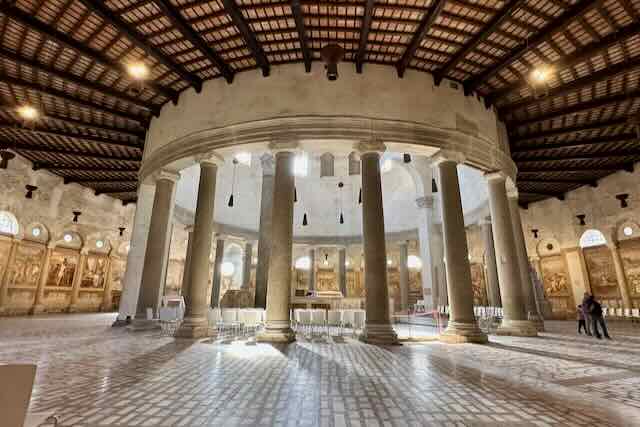
The first time I visited Santo Stefano Rotondo, I had no idea what to expect.
I'd heard it was the largest circular church in Rome, and that it was really special.
But nobody told me in advance about the artwork I'd find on the walls.
The first thing that struck me was the unusual shape, and how I could see the church and its enormous internal columns all around me.
The ceiling is especially tall and a lot of light streams in, giving the whole interior an ethereal look.
I note this every time I go, no matter what time of day.
On that first visit, I walked around the church to get a closer look.
I was completely shocked by the paintings.
Every wall of this church is covered with depictions of hideous executions, of the kind we cannot even fathom.
And the most bizarre thing to note is the look of happiness and peace on the face of the martyr accepting his or her fate.
Visiting this church is not for the faint-hearted, but if I can do it, anybody can.
The beauty of the church itself is not to be missed.
Santo Stefano Rotondo - A Short History
Santo Stefano Rotondo (full name in Italian: Basilica di Santo Stefano al Monte Celio) was built at the end of the 5th century by Pope Simplicius.
The church was dedicated to Saint Stephen, one of the first Christian martyrs.
Originally the church had three concentric sections but in the 12th century the outer-most section was removed.
At one point the building fell into complete disrepair but in the 15th century it was revived and restored.
The church suffers from humidity and when you visit it, you can see that the frescoes are in constant need of restoration (they were most recently restored in 2021 - 2023.)
During the years of the Grand Tour, it was thought this church was built on a pagan Roman temple, but actually the original building was always a church.
In 1583 Pope Gregory XIII commissioned the frescoes you see on the rounded walls today.
They portray the martyrdom of the apostles and other early saints.
Santo Stefano Rotondo is now the National Church in Rome of Hungary.
Santo Stefano Rotondo - Special Things
Unique architecture
One of the things that make this one of the most special churches in Rome is the unique architecture.
It's really breathtaking to walk into this church and look around you, in every direction.
I never get tired of it.
Gruesome frescoes you can't Stop Looking at
Certainly the second thing that makes Santo Stefano Rotondo one of the most special churches in Rome is its really horrifying artwork.
I am very squeamish, and I used to think the artwork in the basilica of Santa Maria degli Angeli e dei Martiri (also on this page), was really disturbing.
But nothing comes close to the images on the walls of Santo Stefano Rotondo.
As awful as the scenes are, they are somehow compelling.
In part, I can appreciate their beauty if I can try not to not think about what is depicted.
But in part, I do think about the scenes and think...did they use to DO that to people?
Really?
It's so grotesque, it's almost impossible to believe.
Charles Dickens visited this church and wrote about it. If you'd like to read his description, go here.
Santo Stefano Rotondo - Address and Hours
Via di Santo Stefano Rotondo, 7
Winter hours: Tuesday - Sunday 10 am - 1 pm, 2 pm - 5 pm
Summer hours: Tuesday - Sunday 10 am - 1 pm, 3:30 pm - 6:30 pm
Closed Mondays
Santa Maria in Domnica alla Navicella
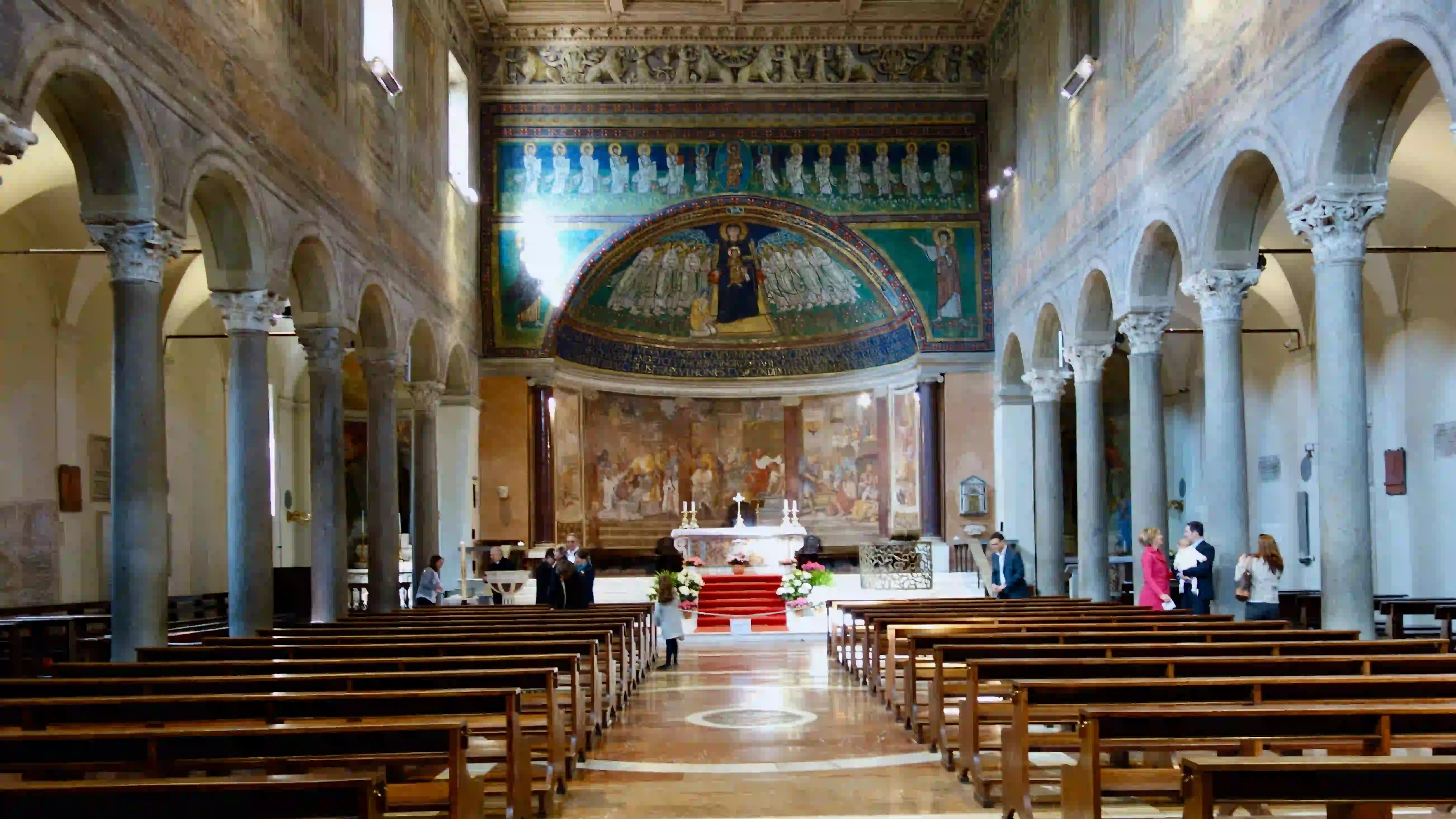
Santa Maria in Domnica is another one of those special churches in Rome that does not look so interesting from the outside.
But every time I walk in, I'm struck by the decorated ceiling high above me, the majestic, ancient columns on either side, and that sparkling 9th century mosaic over the apse.
This quiet, beautiful basilica is not far from the Colosseum.
See how empty it is?
It's mostly like that unless there is a baptism or wedding (as in this photo.)
I took this photo in the morning, so the sun is beaming onto the glass tiles of the mosaic, but there is also a little machine near the entrance, where you can put in a coin and light up the apse for about 60 seconds.
Jump start your trip to Rome with a free ebook 😀
Sign-up to our free newsletter and receive our Quick Start Guide to Rome ebook which share's everything you need to know to plan the perfect trip to the Eternal City 🙌
Santa Maria in Domnica - a Short History
Like Santa Prassede, Santa Maria in Domnica was (probably) built around the 4th century, then rebuilt again by Pope Pascal I in the early 800's.
Pope Paschal I was on a bit of a mission to re-build churches that were in disrepair, and he was responsible for the rebuilding, and the spectacular mosaics, of Santa Pressede, Santa Maria in Domnica and the nearby Basilica of San Clemente.
The 18 columns lining the central nave are made of spolia, which means they were recycled from some other Ancient Roman building(s).
If you look closely you will see they don't all match each other.
Exploring Roman ecclesiastical architecture and art treasures takes you through various styles, from ancient catacombs to Saint Peter's Basilica's grandeur.
Disclosure: If you make a purchase through a link on this page, I may receive a small commission - at no extra cost to you. Thank you for supporting my site!
Santa Maria in Domnica - Special Things
The "navicella", or little boat
The basilica is also called Santa Maria alla Navicella because of the boat sculpture in front of it.
This boat is a replica of an ancient sculpture placed there by the sailors who lived in the area at the time.
These sailors' main job, when they were not actually at sea, was to manage the Velarium, or the giant wing-like tarpaulins that covered the spectators at the Colosseum when it rained or was too hot.
They made the boat as an offering to Isis, protectress of the sailors.
The boat was mostly lost but eventually in the 1500s, Pope Leo X had a replica made.
There was no aqueduct reaching this area, so it was not a fountain until 1931, when the aqueduct system was vastly expanded in Rome.
The wooden ceiling and medici crest
If you look up at the ceiling right in the middle you will see a Medici crest.
The Medici were a very wealthy dynasty from Florence, but they were also popes and cardinals, and this church was under their title at the time.
Many members of the Medici family had a hand in renovating and embellishing this basilica, so that is why you see the Medici crest on the ceiling.
The apse mosaics
In the apse, Pope Paschal I is once again part of the scenery, and as in the basilica of Santa Prassede, he is depicted with a square halo, or nimbus, because he was alive when the mosaic was designed.
Note also the looks on the faces of Mary and also Jesus.
They are relaxed and happy, which was very unusual for the time.
Santa Maria in Domnica - Address and Hours
Via della Navicella, 10
9 am -12 pm, 3:30 pm - 6 pm
Santi Giovanni e Paolo
Santi Giovanni e Paolo is another one of my favourite special churches in Rome, maybe because I get to see it a lot.
What I love about this church is the setting: To get to it, you have to come down (or up) a little-visited street, and once you enter this street, you already get a sense of being lost in time.
From the Colosseum, walk up the via Claudia.
On the right, you will come to an ancient Roman wall and archway, called the Arco di Dolabella.
That street will take you to this church.
(This street is right before the basilica of Santa Maria in Domnica, and the street that takes you to Santo Stefano Rotondo, so as I said, you can easily visit these churches all together.)
As you walk, you will pass a vine-covered wall on your left, and private villas to your right.
All of a sudden, you come upon this wide open plaza.
There is a really tall, perfectly intact Romanesque bell tower, and to the left, also sitting pretty on the plaza, the church.
You can visit the ruins of the temple of Claudius under the bell tower.
Then you can visit this church with its rich cosmatesque floor and uniquely painted apse.
And, if you really want the most special treat of all, you can spend another 30-60 minutes visiting the Roman Houses at Celio, underneath the church.
It is really a wonderful experience, allowing you to see incredibly intact buildings from Roman times, with bright frescoes, a wine cellar, a religious altar, and much more.
And at the end, you can see one of the best-designed archeological museums in Rome, even if it is small.
But even just visiting the church itself is worthwhile.
Santi Giovanni E
Paolo - A Short History
The Church of Santi Giovanni e Paolo dates back to the 5th century.
It was constructed on the site where two Roman soldiers, John and Paul, were martyred during the reign of Emperor Julian in the 4th century.
These soldiers are now venerated as the church's patron saints.
You can see images of them in the church's ceiling.
The church has undergone a lot of restorations throughout the centuries.
One of the most significant medieval modifications was the addition of a Romanesque bell tower, added in the 12th century.
Santi Giovanni E
Paolo – Special Things
The Romanesque Bell Tower
The Romanesque bell tower of the Church of Santi Giovanni e Paolo is an excellent example of medieval architecture in Rome.
Constructed in the 12th century, the tower reaches a height of about 35 meters (approximately 115 feet).
The windows are framed with decorative stone elements.
THe ruins of The Temple of Emperor Claudius
Underneath the bell tower you can see the ruins of the temple to Emperor Claudius.
This temple, known as the Temple of Claudius (Templum Divi Claudii), was constructed by Claudius' successor, Emperor Nero, in the mid-1st century CE.
The temple honored Claudius, who was deified after his death.
The ruins of the Temple of Claudius are extensive, stretching across a huge section of this hill, nearly touching the Colosseum on the other side.
You can visit these ruins under the bell tower for free when it is open, which seems to be sporadic.
The apse architecture
The apse of the church is best appreciated from the outside.
It's the only one like it in Rome.
The external architecture of the apse of Santi Giovanni e Paolo is unique in Rome due to its prominent and beautiful design design.
Constructed in the 5th century, the semi-circular apse is both beautiful and structurally important, shoring up the church with its imposing buttress.
If you look carefully at the apse from a little down the street (Clivo di Scauro), you can see the integration of spolia, repurposed materials from earlier Roman buildings, including ancient columns and stones.
THe Roman Houses at Celio
The Roman Houses at Celio is a fantastic site from Ancient Rome underneath the church.
It's well worth the 6€ price of admission and half hour of your time.
The chandeliers
One of the reasons I love this church is it's the only church with a bit of kitsch in Rome: the whole place is adorned with chandeliers, which were a gift from the church's titular, Cardinal Francis Spellman of New York, in the 50's.
The chandeliers had previously hung in the Waldorf Astoria in New York.
Spring for 5€ to light them up.
You will not be disappointed!
Santi Giovanni e Paolo - Address and Hours
Piazza dei Santi Giovanni e Paolo, 13
Open daily from 8:30 am - 12 pm (Sundays until 12:45 pm), 3:30 pm - 6 pm
Ready to plan your trip?
Book your train
Planning to travel between cities in Italy and other parts of Europe?
Use Trainline to see all the different options available across the different rail companies.
Find your hotel
Find your perfect place to stay in Rome.
Use Booking.com to choose between hotels, guesthouses, and self-catering apartments in neighborhoods throughout the Eternal City.
Buy your TurboPass
Purchase the convenient Turbopass and visit all of Rome's top attractions including the Colosseum, Pantheon, and Vatican.
With one handy pass, it's all included.
Santi Cosma e Damiano
You're walking along the via dei Fori Imperiali, heading to the Colosseum, and if you blink, you will miss this wonderful ancient church.
Santi Cosmo e Damiano is so easily overlooked and therefore so delightful when you do go in.
First you have the pretty little courtyard with the fish fountain the the middle.
Then, when you enter the church, you will have to decide whether to look at the 6th century apse with its simplistic yet beautiful mosaics, or, whether to look to the right to see the ancient temple of Romulus below you.
Santi Cosma e Damiano - a Short History
The basilica of Santi Cosma e Damiano was built in 527, commissioned by Pope Felix IV.
The church was made of a combination of two buildings: a rectangular hall whose functions are not quite clear, and also a round temple, called the Temple of Romulus, which the emperor Maxentius dedicated to his son Romulus, who died as a boy.
This temple is thought to have been built on an earlier temple from 2-3 BCE, called the Temple of Jupiter Stator.
In any case, the temple is the second best-preserved round pagan temple in Rome after the Pantheon.
It was the first church to be built inside the Roman Forum.
This was actually a big deal at the time.
Although Christianity had taken hold, most Romans were still practicing pagan religions, and the building of this church inside the forum shows how much sway the church was beginning to have.
Santi Cosma e Damiano is named for twin brothers and saints from Greece, who were doctors, and of course martyrs.
The entrance to the church, from the Via Fori Imperiali, was never its original entrance.
You were meant to enter from the Forum.
But the current entrance was added much later, and today, you cannot go inside from the forum, although you can see the exterior of the original temple of Romulus, with its huge original bronze doors.
The key to open those doors still works today.
Santi Cosma e Damiano - Special Things
Apse mosaics
It would be difficult to miss the 6th century Roman-Byzantine mosaic in the apse.
This spectacularly intact mosaic depicts the Second Coming of Christ.
Temple to Romulus / Temple to Jupiter stator
At the back of the church, you can look down into the pagan temple of Jupiter Stator (3rd-century BCE), visible through the glass of the basilica.
The temple was later called Tempio di Romolo, or Temple to Romulus, dedicated by Maxentius to his son Romulus who died as a boy.
Permanent Nativity Scene
The nativity scene (on display year-round) in one of the rooms off the cloister.
Naples is famous for their Presepe, or nativity scenes.
One of the best examples of a work by some of these master craftsmen is inside the church of Santi Cosma e Damiano.
Don't miss this, even if it's not Christmas!
Santi Cosma e Damiano - A curiosity
From the Via dei Fori Imperiali, you can see the outer wall of this church.
This wall was where the marble map of Rome once hung during the Roman Empire.
You can visit the fragments of this map, which have been brilliantly laid out in the floor under the imprint of a more modern (18th century) map at Rome's Museo della Forma Urbis, not far from the Colosseum.
Santi Cosma e Damiano - Address and Hours
Via dei Fori Imperiali 1
Open daily 10 am - 1 pm, 3 pm - 6 pm
Saint Ignatius/Sant'Ignazio
I used to tell our hotel guests, you have to go to Saint Ignatius to see the optical illusion.
But I wouldn't tell them what the illusion was.
It was so neat, I thought they should see it for themselves.
Every time, people would come back and tell me they couldn't find it.
It's that well done.
When you walk into Saint Ignatius (Sant'Ignazio di Loyola a Campo Marzio), the first thing that grabs you is the amazing ceiling.
It just seems to sweep you up into it.
In fact, many people told me they thought that was the optical illusion I was talking about.
The ceiling is painted with a lot of really well-done techniques, that make flat walls look like soaring columns of marble, and that make all the figures in the ceiling really look as if they are ascending.
And as you are standing there gazing at this ceiling, you will also notice a high dome, with light pouring through, closer to the apse.
If you go stand directly under the dome, you will see it is completely flat.
The dome is not there: the perfect trompe-l'œil (optical illusion.)
(NB _ when I wrote this page, this church was very often empty and quiet. Since tourism has surged in Rome post-pandemic, I now almost always find it crowded with long lines to see the ceiling via a mirror placed in the central nave. Skip the mirror and go stand under the dome.)
Saint Ignatius - a Short History
St. Ignatius of Loyola, the founder of the Jesuit order, was canonized in 1622.
This church was built, under the orders of Pope Gregory XV (and financed by his nephew, Cardinal Ludovico Ludovisi.)
The fresco paintings on the ceiling of the central nave were painted in 1685 by Fr. Andrea Pozzo.
He used formidable artistic skills to create the illusion that the sky is 3-dimensional above you.
Initially, the church was supposed to include a dome.
However, once the church was near completion, the Jesuits found they were out of money to build it.
To make the church look complete at least from the inside, Andrea Pozzo suggested he create a temporary dome on the 17-meter space where it was supposed to go.
It's stayed that way ever since.
Saint Ignatius - Special Things
The optical illusion of the dome is absolutely wonderful, but there are more...
As you stand under the dome that isn't there, turn back to face the main entrance.
You will see one of the figures in the ceiling reaching out with his arm.
In fact, his finger gets to the edge of the window and should be then cut off, but it continues off the painting, and sticks out over the window.
Now turn back around and face the altar over the apse.
On the left, there is an angel sitting close to the edge.
His robe comes out of the painting and drapes down over the cornice.
Saint Ignatius - Address and Hours
Piazza Sant'Ignazio
Open daily 9 am - 11:30 pm
Sant'Agostino
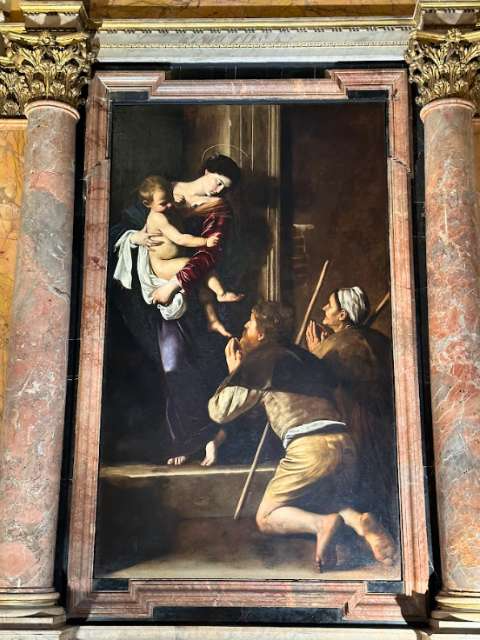
If you're looking for Caravaggio paintings in Rome, you may have visited the slightly more visible and better-known churches of Santa Maria del Popolo, and San Luigi dei Francesi.
But it seems to me that every time I go into Sant'Agostino (which I do every time I pass it and it's open), there is almost nobody there.
This breathtaking painting by Caravaggio (Madonna di Loreto, also called Madonna dei Pellegrini) makes the church of Sant'Agostino one of my favourite churches in Rome, in part because it seems to just be "another painting".
But pay the 1 Euro to light it up, and take a closer look.
It's Caravaggio doing what he does best:
- His use of chiaroscuro (using light and dark contrasts) to make the painting's theme really stand out)
- Using real people as models, showing all their human flaws: literally, warts and all
Note also the bare feet, both of the Virgin Mary, and the dirty feet of the beggars, which caused a scandal at the time.
✨ Experience all of Rome's Magic in a Day ✨
Wander through the city's historic center with a local guide, discovering iconic landmarks like the Trevi Fountain, Pantheon, and Piazza Navona — then take a private transfer to The Vatican. Perfect for first-time or hundreth-time visitors, this expertly guided tour reveals the Eternal City’s beauty and rich history at its most enchanting.
Sant'Agostino - a Short History
The building of Sant'Agostino began in 1296, but was not finished until 1420.
Sant'Agostino is one of the first Roman churches to be built in the Renaissance.
The interior was designed and embellished several times over from the 1400's through the 1700's, and contains some works by some of the most famed artists of the time, including Caravaggio, Raphael, Guercino, and Sansovino.
Sant'Agostino - Special Things
Madonna of the Pilgrims by Caravaggio
Of course, the most special thing in this church is the Caravaggio painting of Madonna of the Pilgrims (1604), in the first chapel on the left-hand side of the church.
Raphael Fresco
Note the third pillar to the left of the nave: there is a fresco by Raphael depicting the "Prophet Isaiah " (1512.)
Why there are so many steps to reach the church
The church is located in the Campo Marzio neighbourhood, the lowest point sea-level in Rome.
It used to flood in this area, because they developed a decent drainage system.
So this church, and many others in the area, is reachable by climbing a flight of stairs, meant to keep the church safe from the floods.
The Renaissance façade
The Renaissance façade, built in 1483, is partially made from travertine taken from the Colosseum.
It was designed to look like the Florentine church Santa Maria Novella.
Sant'Agostino - a Curiosity
In the late Renaissance, the church was noted for the high number of courtesans and prostitutes in its congregation.
The painting by Caravaggio is in a way a tribute to these ladies, as the model he used for the Madonna was a Roman prostitute.
Sant'Agostino - Address and Hours
Piazza di Sant'Agostino
Open Monday - Saturday 7:30 am - 12 pm, 4 pm - 7:30 pm
Open Sundays 8 am - 12:45 pm, 4 pm - 7:30 pm
Special Churches in Rome - A walking route to see them all
I have mapped out the best way to see these churches in one morning, one afternoon, or one full day.
The whole walk itself takes about 2 hours, without stops.
But considering that you will want to go in for a look, you should allow yourself an entire 4-hour block of time if you can.
If you try to visit them all in one day, I'd suggest taking a lunch break in between since most of these churches close in the middle of the day.
You could go from one direction or the other.
Romewise's Top Travel Resources
Ready to book your trip to Rome? Take a look at these helpful links to companies we use and trust:
- Keep your travel spending simple with the Wise card, which removes all the worry about exchange rates and high transaction fees all over the world
- Search for and book your perfect accommodation
- Our complete guide to what to pack for Rome
- The number one travel accessory, a multi-point travel adapter and voltage converter
- Browse a huge range of tours in Rome and beyond
- Experience unique tours and special access to Rome's most popular sights
- Protect yourself with comprehensive travel insurance
Within this post there are some affiliate links for products and services. For more details about our affiliate policy click here.
Get your 100% free Rome trip planner now!
Simply sign-up today for our free newsletter and get the Romewise Quick Start guide to Rome:
We are committed to respecting your data. Click for our Privacy Policy.
Comments? Questions? Suggestions?
Please come over to the private Romewise Facebook group and join in the conversation.
You will often find me there, happy to answer your questions / comments!
You will also meet other Rome lovers and experts, too.
What are you waiting for?
- Romewise Home Page
- What to Do in Rome
- Romantic Things to Do in Rome
- Special Churches in Rome

